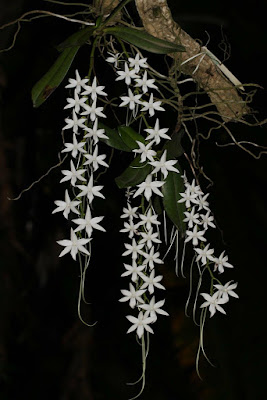Aerangis articulata is found in Madagascar and the Comoro Islands. It grows on trunks and major branches of forest trees at elevations of sea level to 2000 meters.
Aerangis articulata also called as The Articulated Aerangis, Aerangis venusta, Aerangis calligera, Angorchis articulata, Angraecum articulatum, Angraecum calligerum, Angraecum descendens, Rhaphidorhynchus articulatus, is a species of the genus Aerangis. This species was described by Rudolf Schlechter in 1914.
IDENTIFY AERANGIS ARTICULATA ORCHID PLANT
Aerangis articulata is found in Madagascar and the Comoro Islands. It grows on trunks and major branches of forest trees at elevations of sea level to 2000 meters.
It is a miniature to small sized epiphytic, hot to warm growing species with short, stout stems carrying several obovate or oblong-obovate, coriaceous, obliquely 2 lobed apically leaves.
The Articulated Aerangis blooms in the fall on an axillary, 22.5 to 45 cm pendant, racemose sometimes branched, stout inflorescence with up to 18 scented, long-lived, waxy flowers.
AERANGIS ARTICULATA ORCHID PLANT CARE AND CULTURE
Cultural information should only be used as a guide, and should be to be adapted to suit you. Your physical location; where you grow your plants, how much time you have to devote to their care, and many other factors, will need to be taken into account. Only then can you decide on the cultural methods that best suit you and your plants.
Aerangis articulata grows under normal lighting conditions and sometimes flowers twice in a year. However, the main flowering period is from March to May. A place in the temperate greenhouse is sufficient, but it can also be cultivated very well in the warm greenhouse.
Like all Aerangis species, The Articulated Aerangis should never completely dry out, so that a daily, especially in the summer months, morning overspray is advisable. It must be ensured sufficient ventilation, so that no waterlogging arise.
In practice, it has been shown that the plants are best tied up. However, it also grows in pot culture. When mounted the plants, possibly used as cork bark or grapevine. As a substrate, sphagnum is recommended. In this culture, however, in the warm summer months repeated, daily overspray is required. Place near a air humidifier is very advisable.
In pot culture the substrate can be bark, peat and charcoal. It should definitely be to one drainage from polystyrene or pebbles to be thought of 1/3 of the pot. In the pot culture, ensure that sufficient fresh air is supplied to the plant, what is particularly important in the winter months, as often waterlogging in the root area can cause damage.
A daytime temperature around 18 ° C with a night lowering by about 4 ° C has proven itself in culture. Offers itself as a cultural space a place between Phalaenospsis or Cattleya. In the winter months, there are often very hazy and dark for days. Therefore, it should be remembered in the pot culture that most successful pots is hanging. A place in the upper part of the greenhouse still bring enough light.















COMMENTS